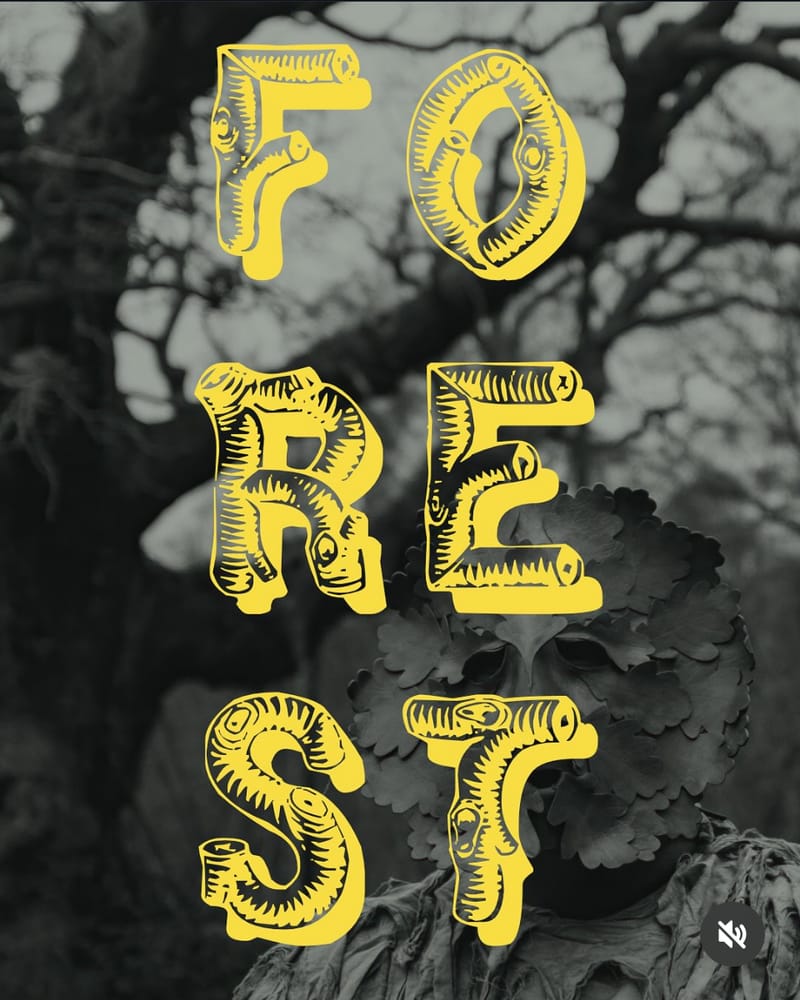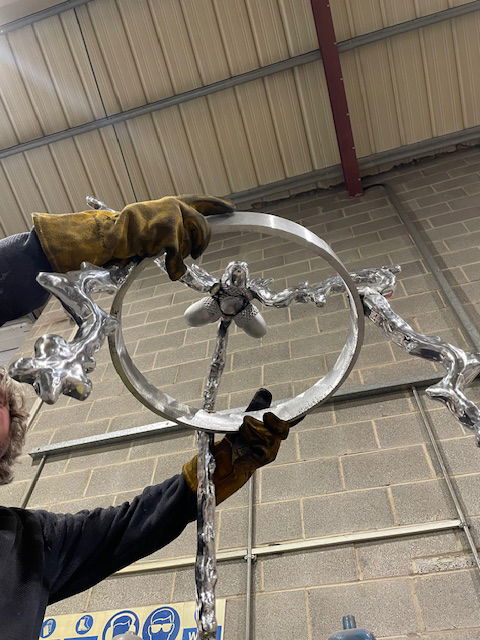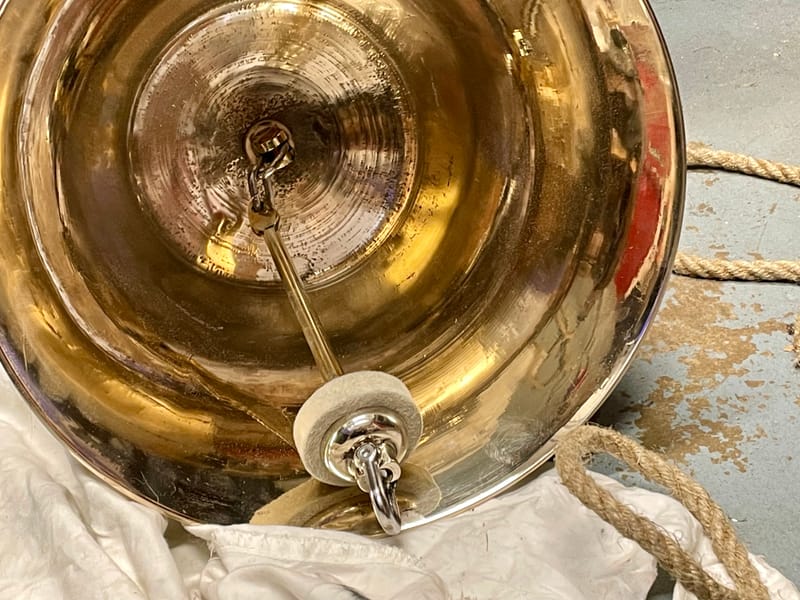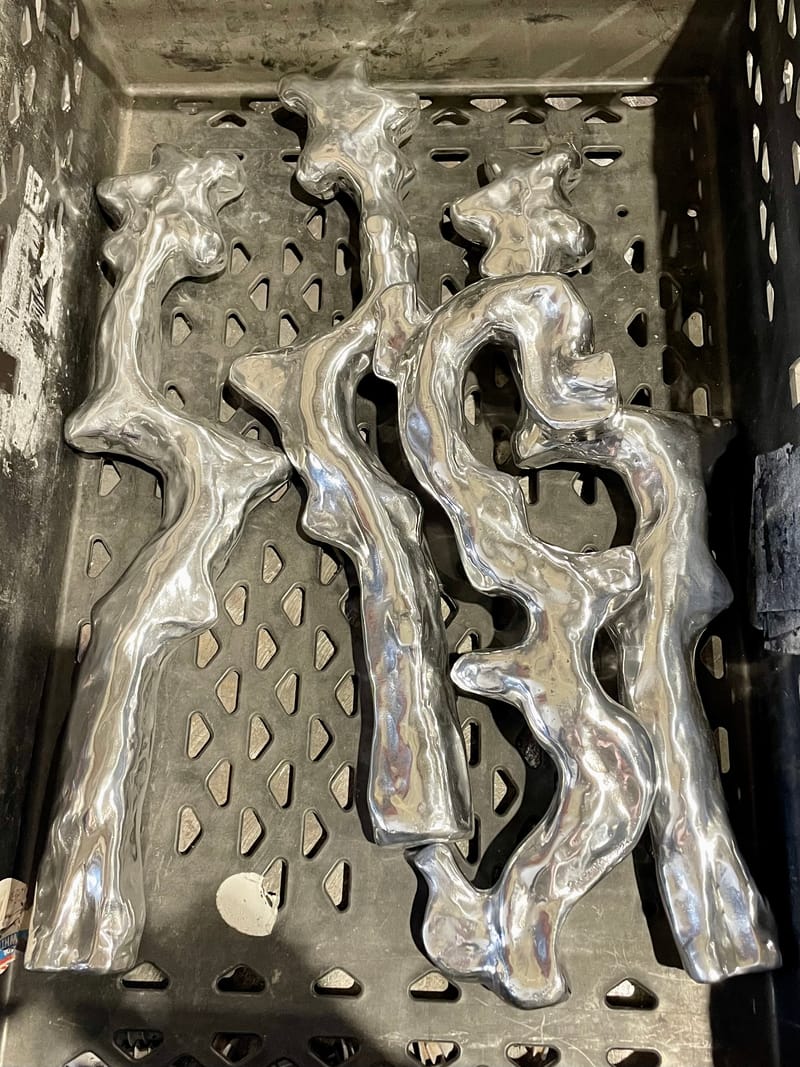SIGNIFICANT
TREES
CAROLINE LOCKE
Projects
The Major Oak Projects
Caroline Locke’s Major Oak Projects are part of her ongoing artistic exploration into how instruments, data, sound and emerging technologies can deepen our awareness of the natural world. Central to the work is the process of venturing into the forest to gather different kinds of ‘tree data’ – frequency readings, tree fruit, historical and ecological information, and collecting personal stories in connection to the Major Oak. These ‘data collecting’ excursions bring her into direct contact with individuals, organisations and communities, and create meaningful connections. Over the past year, the project has grown through a series of consultations, technical meetings, forest visits, and creative experiments. These collaborative processes have shaped a body of work that responds to the rhythms and resonance of Sherwood Forest itself. Locke’s evolving practice transforms ecological research into embodied encounters. At its core is an invitation: to reconnect through the body, listen, and imagine new ways of being with nature. With thanks to Nottingham Castle Museum & Art Gallery for commissioning this work, to researchers from the University of Nottingham, the technical team at the University of Derby, Taylor Bells and the RSPB for their generous support.
In 2024 Nottingham Castle, UK, invited Caroline to work on a year long project in connection with their own Collection, including the iconic, large-scale painting of the Major Oak (1882) by Nottingham-born artist Andrew MacCallum. They commissioned six of her new works which are currently part of the Forest Exhibition in their galleries.Forest
FOREST is an exhibition that delves into the myth and magic of arboreal art, exploring how this timeless and powerful totem can shape artistic thought and creative practices. The exhibition showcases six newly commissioned works created exclusively for Nottingham Castle, in the company of prints, drawings and photographs from Nottingham’s own Collection, including the iconic, large-scale painting of the Major Oak (1882) by Nottingham-born artist Andrew MacCallum (1821-1902). Some artists have reflected on deeply personal connections to Sherwood Forest or the Major Oak, while others take a broader perspective, exploring the essence of woodlands or their relationship with a greenwood canopy, venturing into themes of perambulation, folklore and climate change. FOREST concludes with scientific contributions and research from specialists at the University of Nottingham who have focused on the Major Oak, which has helped inform the work by commissioned artist Caroline Locke, and collated in a film by Georgianna Scurfield.
https://www.nottinghamcastle.org.uk/forest/Recording Data from the Forest
Influenced by the scientific theory that all things vibrate, Locke has experimented with recording the movement of trees and exploring ways to relate this information to sound. The frequency of sound is measured by counting the number of occurrences of an event per unit of time. By measuring the number of times a branch or leaf on a tree moved a certain distance within a set time frame, Locke could equate tree movements with Hertz readings, the unit used to measure sound. Working with a programmer, she has also developed software to record the frequency of certain trees using a highly sensitive sensor. Using this technique, Caroline collected frequency readings from many different trees within Sherwood Forest. These were translated into digital string tones, tuned to the Hertz readings of single trees, and ambient compositions, rooted in the acoustic presence of the forest, were then created.
Forest Bell
Forest Bell (2025) Bronze, copper, aluminium, wood and wool. The Forest Bell is part of Caroline Locke’s Significant Tree Bell collection—a series of bronze handbells, each precisely tuned to the unique harmonic frequencies of individual trees. These 'warning' bells are calibrated to resonate at a specific pitch when the air temperature is 21°C, serving as a deliberate reference point. As temperatures rise, the pitch subtly increases, making audible the often-invisible imprint of climate change. This particular bell is tuned to one of the younger oak trees growing near the legendary Major Oak, grounding it in a specific ecological and cultural context. Across cultures, bells have historically been used to signal danger, bring communities together, or mark transitions. In this work, the handbell functions as both symbol and instrument—amplifying the forest’s voice and acting as a call to environmental awareness. Locke invites us to tune in to more-than-human rhythms and to consider what it means to truly listen. The bell stand has been specially designed so that the vibrations produced by the ringing bell travel through its wooden legs. By touching the stand, participants can physically feel the sound—creating a tangible, embodied connection to the forest and reinforcing the idea that nature speaks not only through sight and sound, but also through sensation.
The Bell and the Oak
(2025) Bronze, nylon In this work, Caroline explores the hidden vibrational life of one of Britain’s most iconic ancient trees—the Major Oak in Sherwood Forest. Collaborating with engineers using advanced software and laser scanning technology, she set out to determine the tree’s frequency. After an extended process of analysis, the tree’s resonant frequency was calculated at 0.27Hz. Translating this reading into sound posed a challenge. A bell capable of resonating at 0.27Hz would need to be over 120 meters in diameter and would not vibrate on Earth because of gravity. This physical impossibility became a conceptual turning point in the project. Rather than attempting to produce the impossible sound, Locke created a sculptural response. By scaling down a 3D model of the Major Oak to the comparative size it would appear beside a 175-year-old tower bell, this pairing, the tree and the bell, enter into a quiet conversation about scale, resonance, and time.
Oikonomos
In the autumn of 2024, Caroline was granted permission to collect fallen leaves from the Major Oak Tree in Sherwood Forest. She carefully coated each leaf in layers of copper, silver, and gold using electroforming and electroplating techniques. The acorns were cast in bronze from real acorns gathered beneath oak trees—some collected from the Major Oak itself in 2019. The title Oikonomos comes from ancient Greek and means “economy” or “household steward”—a person who looks after things with care and responsibility. This artwork invites us to think about how we care for the natural world, especially in a time of climate change. While real acorns can grow into mighty oak trees, these are frozen in time—transformed into objects of beauty but unable to grow. What happens when nature is turned into something we collect, spend, or display, like money? Oikonomos asks us to reflect on what we truly value and how we might protect and nurture the world we share.
The Wandering Forest
Caroline Locke (2025) Glazed stoneware Since 2020, Caroline Locke has been creating a growing collection of ceramic trees with legs. Her ongoing relationship with significant trees inspires these characterful forms, from legendary specimens like the Major Oak to the only remaining memorial tree planted in 1920 by the Suffragettes. Each ceramic walking tree emerges from Locke’s experiences—time spent with trees, pausing, observing, and forming connections. These are not static sculptures but figures in motion: trees walking toward us purposefully. The Wandering Forest encourages a shift in perspective - to see trees not just as background to human life but as beings with agency, memory, and quiet power.
The Forest Fork
Caroline Locke (2025) Mild steel, tempered steel, brass, wood, felt Caroline Locke’s work is grounded in the scientific principle that all matter vibrates. Her ongoing research explores how the subtle movements of trees can be translated into sound, connecting natural rhythms to human perception. By tracking the number of times a branch or leaf moves a certain distance within a set period, Locke equates this motion to frequency, measured in Hertz (Hz), the same unit used to quantify sound waves. Collaborating with a programmer, she developed custom software and employed highly sensitive sensors to record the vibrational frequencies of trees across Sherwood Forest. The Forest Fork is tuned to the frequency of one of the smaller ancient oak trees located near the former visitor centre. At Nottingham Castle, visitors are invited to strike the tuning fork using a beater. As the initial overtone fades, the fork emits a sustained, pure tone—revealing the fundamental frequency of the tree. With a frequency of 32Hz, the fork vibrates near the lower threshold of human hearing (typically 20Hz–16,000Hz), offering a deeply resonant auditory experience. The artwork engages not only the ears but the body. Viewers can observe the fork’s movement and feel the sound by touching the metal resonating chamber, creating a direct, embodied connection between themselves and the tree’s sonic signature.
The Resonant Forest
The Resonant Forest – Film – ( 5 mins) Caroline Locke’s Major Oak Projects explore Sherwood Forest from multiple perspectives. Caroline visited the Castle’s museum archive and encountered Andrew MacCallam’s 1882 painting of the Major Oak—now displayed beside the film loop—which became a key reference point, alongside her study of the Major Oak Tree’s frequency and the creation of a bell tuned to it. The film grew from these conversations, archival encounters, and digital recordings taken during her seasonal visits to Sherwood Forest. Towards the end of the film, the tree from the painting comes to life through computer-generated animation, and a virtual bell appears—sized to ring at the actual frequency of the Major Oak. Locke composed the soundtrack using synthesised strings tuned to frequency readings collected from fourteen significant trees, combined with 360° ambisonic field recordings, grounding the film in the sonic language of the forest itself. CGI animation in collaboration with Spyros Kitsas
https://vimeo.com/1089008578The Forest Bell at Taylor Bells
Caroline's Significant Tree Bells are created at Taylor Bells in Loughborough, UK. John Taylor & Co has been at the heart of British bell craftsmanship since 1784. As the only remaining bell foundry in the UK, Taylors uphold Britain’s heritage of traditional craftsmanship, combining time-honoured techniques with modern expertise and the bell foundry is a fascinating place. Caroline creates her bell canopies according to her own project brief which are different for each significant tree. She sculptured the Forest Bell canopy from clay and then it was cast in aluminium and welded together and polished.
https://taylorbells.co.uk/Forest and Frequency
Forest and Frequency is a series of four films by documentary maker Georgianna Scurfield that follow the Major Oak, artist Caroline Locke, and researchers from the University of Nottingham over the year in the lead-up to this exhibition. Divided into four chapters to reflect the changing seasons, the film centres the Major Oak. It begins in summer 2024 as Locke works with University of Nottingham engineers to record the tree's natural frequency usingstate-of-the-art technology to scan and record specific data points. Subsequent films show the independent journeys of that data, both in the studio to inform Locke’s artistic work and on campus to create a 3D model from which researchers can calculate the vibration of the tree as it sways in the wind. On return visits to Sherwood Forest, we are also introduced to researchers from different academic disciplines who share their insights and relationships with woodland ecosystems. Through conversations held in the forest, creative thinking and knowledge exchange, we see art, science and historical research intertwined in response to the presence of a single, ancient tree. At this event, attendees will have the opportunity to see the film in its entirety for the first time and also ask questions of the artists, academics and professional staff that created the project to bring the mysteries of Sherwood Forest to life.
https://www.nottingham.ac.uk/policy-and-engagement/events/events-2025/forest-frequency-screening.aspx
The Original Bramley Apple Tree Southwell
The first Bramley's Seedling tree grew from pips planted by Mary Ann Brailsford-Trump when she was a young girl in her garden in Southwell, Nottinghamshire, UK in 1809. The tree in the garden was later included in the purchase of the cottage by a local butcher, Matthew Bramley, in 1846. In 1856, a local nurseryman, Henry Merryweather, asked if he could take cuttings from the tree and start to sell the apples. Bramley agreed but insisted that the apples should bear his name.
The Four Yorkshire Sculpture Park Trees
The artist studied four particular trees at Yorkshire Sculpture Park - The Oak, Horse Chestnut, Beech and the Cedar of Lebanon. The trees were photographed and filmed in different seasons. Data was gathered in connection to each tree. Sound recordings of the trees moving and conversations with people about the trees were collected. The precious tree fruit was gathered and cast in bronze preserving memories of the fruitful past. The trees were visited and written about regularly through the seasons.
The Suffragette's Tree
This Austrian Pine tree was planted in 1909 by the Suffragette Rose Lamartine Yates. Between April 1909 and July 1911, at least 47 trees were planted in the grounds of Eagle House, near Bath, to commemorate individual suffragettes and suffragists. Holly trees were planted for those involved in the movement in general, whilst a different species of conifer was planted for each of those women who had been imprisoned. All the trees were destroyed in the late 1960s to make way for a housing estate, but this one solitary pine tree, survives to this day in retired midwife, Eileen Paddock's garden.
The Mighty Oak
This is a veteran oak situated near the main entrance to Yorkshire Sculpture Park as you walk down towards the deer shelter. Sharon Durdant-Hollamby who is VC of the Institute of Chartered Foresters came to scan the roots of this tree. The root scanning data revealed that the roots extend in a 22 meter radius around the tree.
The Frequency of Tree Sculpture
An interactive sculpture was created in relation to the four trees. The Frequency of Trees comprises a series of 12 tuning forks tuned to the frequency of different trees within YSP: Oak, Horse Chestnut, Beech and the Cedar of Lebanon in the Formal Garden. The frequency of sound is measured by counting the number of occurrences of an event per unit of time. By measuring the number of times a branch or leaf on a tree moved a certain distance within a set time frame, Locke was able to equate tree movements with Hertz readings, the unit used to measure sound.
The Frequency of Tree Book
This is a book published by the Yorkshire Sculpture Park and has an introduction written by John Newling. It follows the seasons at the park and four of the trees which the artist tracked and gathered data from in order to make The Frequency of Trees. It is a book about the seasons, nature, data, people, their stories and creating a public interactive sculpture.
Newton's Apples
The National Trust kindly give the artist access to the famous Newton's apple tree. Her Newton’s Apple series consist of Bronze and Aluminium casts of apples harvested from the ‘gravity tree’ at Woolsthorpe Manor, Isaac Newton’s family home. For at least 240 years the tree been shown to visitors as Newton's apple tree, the tree from which an apple fell and caused him to ask the question: 'Why do apples always fall straight down to the ground?'
The Original Bramley Apple Tree Bell
In some cultures, bells are traditionally used to ring out warnings and tell us of danger. The artist began working with bells alongside her art projects where she uses tuning forks in connection to trees and movement.The first bell has now been cast, tuned to the frequency of The Original Bramley Apple Tree in Southwell. The bell resonates at 500HZ when the temperature is 21 degrees, when the temperature changes so too does the resonance of the bell. Caroline intends to cast more Significant Tree bells as she continues to find different approaches for collecting tree data.
The Tree Charter Bell
Caroline’s Tree Charter Bell is a warning bell, used to mark ceremonial tree planting events as part of an ongoing project. As a registered Tree Charter Branch with the Woodland Trust, Caroline is actively seeking opportunities to expand the initiative. The artist has developed a series of “warning bells” tuned to the frequency of trees, with the aim of utilising sound and vibration as mediums to make connections between human physicality and the natural world, promoting a sense of empathy and urgency in the face of environmental crises. The first planting took place during the Woodland Trust’s Tree Charter Festival on Saturday, 28th November 2020, where Nottingham City Councillors participated in a public signing of the Tree Charter. The Tree Charter Bell is rung each time a tree is planted, symbolising commitment and connection to, and celebration of nature. The first saplings were planted across six locations in Nottingham city centre.
https://vimeo.com/531745053The Tree Charter Bell with the Tree Crier
As part of the Woodland Trust's Tree Charter Day Festival the artist planted a new Cherry Tree in Christchurch Gardens in Nottingham City to replace the one blown down in a storm earlier in 2020. The Tree Charter Cryer was part of this ceremony during lockdown. Locke worked in collaboration with the artist Bruce Asbestos to develop the role of The Tree Charter Crier. Drawing from a rich history of painting, sculpture, popular culture, folklore and fairy tales, Bruce mixes everyday objects with high art, fashion, and aspects of popular culture. Caroline wrote Tree Charter 'cries' based on the 10 principals of The Woodland Trust's Tree Charter and Bruce designed the costume based on traditional Town Crier attire. On Tree Charter Day Bruce performed the Tree Cries whilst ringing Locke's Significant Tree bell tuned to the frequency of the Southwell Bramley Apple. We rang the Tree Charter Bell in honour of the new Tree.
Tree Charter Day 2020
On November 28th 2020 the Tree Charter Bell was used in ceremonies to plant 108 trees as part of the Woodland Trust's bid to build a mass movement of people for woods and trees. Caroline has her own Woodland Trust Tree Charter Branch call Significant Trees. The Bell will be part of Branch activities for years to come. See the film in the link
https://vimeo.com/531745053Radford Tree Planting Nottingham
The Tree Charter Bell is part of Caroline Locke's socially engaged practice where she invites members of community's to plant a tree and ring the bell. In 2020 Tree Charter Day was during lockdown so we ran the project with a team of two - the artist and Council Tree Officer Alex Begg. 108 tree were planted. Conversations about trees and the climate emergency were triggered with passers by. The bell was rung each time a tree was planted.
https://vimeo.com/531745053Vibrations in air
Caroline Locke uses sound as part of her art practice. Her interactive public sculpture, The Frequency of Trees comprises a series of 12 tuning forks tuned to the frequency of different trees within Yorkshire Sculpture Park. The frequency of sound is measured by counting the number of occurrences of an event per unit of time. By measuring the number of times, a branch or leaf on a tree moved a certain distance within a set time frame, Locke was able to equate tree movements with Hertz readings, the unit used to measure sound. More recently the artist has replaced the tuning forks with warning bells which are tuned to the frequency of trees. She has been working closely with John Taylor Bell Foundry in Loughborough to create bells in connection to her interactive sculptures.
Tree Charter Day Tree Planting Sites 2020
108 new trees were planted in small green spaces in Radford in Nottingham City Centre. The Tree Charter Bell was part of the planting ceremonies. Each time a tree was planted we rang the bell.
https://vimeo.com/531745053Charter For Trees, Woods And People
The Charter for Trees, Woods and People sets out the principles for a society in which people and trees can stand stronger together. The Tree Charter was launched by the Woodland Trust in 2017. The Tree Charter is rooted in more than 60,000 ‘tree stories’ gathered from people of all backgrounds across the UK. Caroline makes work in relation to tree stories and the Tree Charter. Tree Charter Key Principals are: • Sustain landscapes rich in wildlife • Plant for the future • Celebrate the power of trees to inspire • Grow forests of opportunity and innovation • Protect irreplaceable trees and woods • Plan greener local landscapes • Recover health, hope and wellbeing with the help of trees • Make trees accessible to all • Combat the threats to our habitats • Strengthen our landscapes with trees
Tree Charter Bell Ceremony II
In the Autumn of 2020 Locke was able to announce Nottingham City Council’s agreement with her to sign a pledge to The Woodland Trusts Tree Charter, which outlines 10 principals in connection with the future sustainability of the planet. As part of The Tree Charter Bell Ceremony II on December 5th 2020, Nottingham City Council’s Portfolio Holder for Leisure and Culture, Councillor David Trimble, signed a pledge to the Woodland Trust's Tree Charter resulting in changes in the council’s approach to trees in Nottingham. David was invited to ring the ceremonial bell to mark the important signing of the pledge at Nottingham Forest Recreation Ground and a new memorial oak tree was planted .
Rowan and Oak Tree Planting at The University of Derby
At The University of Derby we celebrated by ringing the Tree Charter Bell as part of a ceremony with the Tree Charter Bell, students and the Vice Chancellor, Professor Kathryn Mitchell in January 2022. Thirty new Oak and Rowan trees were planted.
National Tree Week 2021
National Tree Week is the UK’s largest annual tree celebration and ran from Saturday 27th November to Sunday 5th December 2021. Across the country, people planted thousands of trees to mark the start of the winter tree planting season. On December 1st 2021, in connection with National Tree week, the Tree Charter Bell travelled to The University of Derby. Together with Fine Art and Microbiology Students, Caroline Planted 105 Woodland Trust tree saplings in green spaces at the Kedlestone Road Campus. 15 Silver Birch, Wild Cherry, Hawthorne, Hazel, Dogwood and Rowan saplings were planted and the students rang the Tree Charter bell for each new tree.
Tree Planting at Cannington Primary School
In March 2023 The Tree Charter Bell travelled to Somerset where Caroline returned to her old primary school 40 years on. 106 trees were planted in and around the school field as part of the Woodland Trust’s pledge to plant 50 million trees by 2025 to help tackle climate change. Caroline spent the whole day talking about trees and the environment with each class and every child in the school was involved in the planting ceremonies. The Children rang the bell each time a new tree was planted and each pupil received a Tree Charter Bell certificate to congratulate them on their contribution to helping to combat climate change.
Eco/Art Residency at Furtherfield Commons in Finsbury Park, London
Caroline and The Tree Charter Bell are part of "The When The Future Comes Collective". On Saturday 1st April 2023 as part of an Eco/Art Residency at Furtherfield Commons. We hosted our first Bell Weather Day in Finsbury Park, London. The residency included art, music, ecology, tree planting, bell ringing and talks, with music from Finsbury Park Drumming School. Caroline planted a Rowan tree with members of the community and the tree was honoured, blessed and celebrated by ringing the bell. An informal conversation about art, music, ecology and the future followed and in the evening we hosted a ‘Future Machine Weather Jam’ led by the Future Machine, The Rainmakers and the When the Future Comes Collective, including special guests and The Tree Charter Bell.
When The Future Comes CollectiveTree Planting with Students from West Nottinghamshire College
In December 2024 Caroline Worked with The Sherwood Forest Trust, a charity established in 1995 working with nature, people and communities local to Sherwood Forest. Three hundred trees were planted across 250 hectares of land in Warsop, Nottinghamshire, in partnership with Mansfield District Council, local school children and students from West Nottinghamshire College. Each sapling was planted to the chimes of the Tree Charter Bell. This was an active project with a simple message: plant trees as a meaningful action to contribute to planetary sustainability. The project was filmed to become part of a documentary which will be exhibited at Nottingham Castle in a new exhibition entitled FOREST later in 2025.
https://www.derby.ac.uk/news/2024/tree-charter-bell-raises-awareness-of-climate-change/The Tree Charter Bell is introduced to CEO of Sherwood Forest Trust
Dr Patrick Candler, CEO of The Sherwood Forest Trust, reflects on the Tree Charter Bell: “To hear and see The Tree Charter Bell in action is wonderful. It really gives participants a distinctive and memorable highlight after their tree planting experience" The Sherwood Forest Trust are working hard in partnership with the Greenwood Community Forest. Their ‘Trees for Climate Change’ project – is delivered by a collaboration of 11 community forests and, over the years, they have helped plant thousands of native trees to create new woodland that supports biodiversity, improves water quality and helps to combat climate change. Caroline teamed up with this initiative in Warsop, Nottinghamshire planting with school children and college students. Patrick says “Having the Tree Charter Bell here helps to make an impactful impression which broadens the scope of what we are doing at Sherwood Forest Trust to link people with nature, biodiversity and culture.” Locke works with different organisations every year and, each time a tree is planted through her work, the bell is rung. Its ringing signifies the coming together of the community and triggers discussions about nature, historic places and climate change"
https://sherwoodforest.org.uk/Children from Church Vale Primary School Plant Trees and ring the Tree Charter Bell
Caroline enjoyed many interesting conversations about nature and trees with Church Vale Primary School pupils as they planted new trees in Warsop, Nottinghamshire, on the edge of Sherwood Forest. Working in partnership with Sherwood Forest Trust, Caroline introduced The Tree Charter Bell to the children who then enjoyed celebrating their tree planting activity by ringing the bell.
The Trees
The Hardtwald Forest Chestnut
According to legend, the master plan for the city of Karlsruhe in southwestern Germany came to Karl Wilhelm, a military commander, in a dream as he slept beneath this chestnut tree in the Hardtwald Forest. Karlsruhe is the twin city of Nottingham in the UK, where I am currently based. The Hardtwald Forest Chestnut Tree is closely linked to the founding of Karlsruhe and its distinctive fan-shaped layout. It can be found on the side of the Hardtwald Forest nearest to the Karlsruhe Palace (Karlsruher Schloss).
The Suffragette's Tree
This Austrian Pine tree was planted in 1909 by the Suffragette Rose Lamartine Yates. Between April 1909 and July 1911, at least 47 trees were planted in the grounds of Eagle House, near Bath, to commemorate individual suffragettes and suffragists. Holly trees were planted for those involved in the movement in general, whilst a different species of conifer was planted for each of those women who had been imprisoned. All the trees were destroyed in the late 1960s to make way for a housing estate, but this one solitary pine tree, survives to this day in retired midwife, Eileen Paddock's garden.
The Original Bramley Apple Tree Southwell
The first Bramley's Seedling tree grew from pips planted by Mary Ann Brailsford-Trump when she was a young girl in her garden in Southwell, Nottinghamshire, UK in 1809. The tree in the garden was later included in the purchase of the cottage by a local butcher, Matthew Bramley, in 1846. In 1856, a local nurseryman, Henry Merryweather, asked if he could take cuttings from the tree and start to sell the apples. Bramley agreed but insisted that the apples should bear his name.
The Four Yorkshire Sculpture Park Trees
The artist studied four particular trees at Yorkshire Sculpture Park - The Oak, Horse Chestnut, Beech and the Cedar of Lebanon. The trees were photographed and filmed in different seasons. Data was gathered in connection to each tree. Sound recordings of the trees moving and conversations with people about the trees were collected. The precious tree fruit was gathered and cast in bronze preserving memories of the fruitful past. The trees were visited and written about regularly through the seasons.
The Mighty Oak
This is a veteran oak situated near the main entrance to Yorkshire Sculpture Park as you walk down towards the deer shelter. Sharon Durdant-Hollamby who is VC of the Institute of Chartered Foresters came to scan the roots of this tree. The root scanning data revealed that the roots extend in a 22 meter radius around the tree.
The Frequency of Tree Sculpture
An interactive sculpture was created in relation to the four trees. The Frequency of Trees comprises a series of 12 tuning forks tuned to the frequency of different trees within YSP: Oak, Horse Chestnut, Beech and the Cedar of Lebanon in the Formal Garden. The frequency of sound is measured by counting the number of occurrences of an event per unit of time. By measuring the number of times a branch or leaf on a tree moved a certain distance within a set time frame, Locke was able to equate tree movements with Hertz readings, the unit used to measure sound.
The Frequency of Tree Book
This is a book published by the Yorkshire Sculpture Park and has an introduction written by John Newling. It follows the seasons at the park and four of the trees which the artist tracked and gathered data from in order to make The Frequency of Trees. It is a book about the seasons, nature, data, people, their stories and creating a public interactive sculpture.
Newton's Apples
The National Trust kindly give the artist access to the famous Newton's apple tree. Her Newton’s Apple series consist of Bronze and Aluminium casts of apples harvested from the ‘gravity tree’ at Woolsthorpe Manor, Isaac Newton’s family home. For at least 240 years the tree been shown to visitors as Newton's apple tree, the tree from which an apple fell and caused him to ask the question: 'Why do apples always fall straight down to the ground?'
The Original Bramley Apple Tree Bell
Bells are traditionally used to ring out warnings and tell us of danger. The artist began working with bells instead of tuning forks in connection to trees and movement.The first bell has now been cast, tuned to the frequency of The Original Bramley Apple Tree in Southwell. The bell resonates at 500HZ when the temperature is 21 degrees, when the temperature changes so too does the resonance of the bell. Caroline intends to cast more Significant Tree bells as she continues to find different approaches for collecting tree data.
The Tree Charter Bell
'The Tree Charter Bell' is used to create ceremonies around tree planting activities over the coming years. Caroline has her own Tree Charter Branch and is seeking out opportunities in order to extend the project. The first tree planting event will take place as part of the Woodland Trust’s Tree Charter Festival on Saturday 28th November 2020. Nottingham City Council will be signing the Tree Charter as part of a ceremonial event in the centre of the city. The Charter Tree Bell will be rung each time one of the Woodland Trust’s 108 Saplings are planted in 6 locations in the city.
https://vimeo.com/531745053The Tree Charter Bell with the Tree Crier
As part of the Woodland Trust's Tree Charter Day Festival the artist planted a new Cherry Tree in Christchurch Gardens in Nottingham City to replace the one blown down in a storm earlier in 2020. The Tree Charter Cryer was part of this ceremony during lockdown. Locke worked in collaboration with the artist Bruce Asbestos to develop the role of The Tree Charter Crier. Drawing from a rich history of painting, sculpture, popular culture, folklore and fairy tales, Bruce mixes everyday objects with high art, fashion, and aspects of popular culture. Caroline wrote Tree Charter 'cries' based on the 10 principals of The Woodland Trust's Tree Charter and Bruce designed the costume based on traditional Town Crier attire. On Tree Charter Day Bruce performed the Tree Cries whilst ringing Locke's Significant Tree bell tuned to the frequency of the Southwell Bramley Apple. We rang the Tree Charter Bell in honour of the new Tree.
Tree Charter Day 2020
On November 28th 2020 the Tree Charter Bell was used in ceremonies to plant 108 trees as part of the Woodland Trust's bid to build a mass movement of people for woods and trees. Caroline has her own Woodland Trust Tree Charter Branch call Significant Trees. The Bell will be part of Branch activities for years to come. See the film in the link
https://vimeo.com/531745053Radford Tree Planting Nottingham
The Tree Charter Bell is part of Caroline Locke's socially engaged practice where she invites members of community's to plant a tree and ring the bell. In 2020 Tree Charter Day was during lockdown so we ran the project with a team of two - the artist and Council Tree Officer Alex Begg. 108 tree were planted. Conversations about trees and the climate emergency were triggered with passers by. The bell was rung each time a tree was planted.
https://vimeo.com/531745053Vibrations in air
Caroline Locke uses sound as part of her art practice. Her interactive public sculpture, The Frequency of Trees comprises a series of 12 tuning forks tuned to the frequency of different trees within Yorkshire Sculpture Park. The frequency of sound is measured by counting the number of occurrences of an event per unit of time. By measuring the number of times, a branch or leaf on a tree moved a certain distance within a set time frame, Locke was able to equate tree movements with Hertz readings, the unit used to measure sound. More recently the artist has replaced the tuning forks with bells which are tuned to the frequency of trees. She has been working closely with John Taylor Bell Foundry in Loughborough to create bells in connection to her interactive sculptures.
Tree Charter Day Tree Planting Sites 2020
108 new trees were planted in small green spaces in Radford in Nottingham City Centre. The Tree Charter Bell was part of the planting ceremonies. Each time a tree was planted we rang the bell.
https://vimeo.com/531745053Charter For Trees, Woods And People
The Charter for Trees, Woods and People sets out the principles for a society in which people and trees can stand stronger together. The Tree Charter was launched by the Woodland Trust in 2017. The Tree Charter is rooted in more than 60,000 ‘tree stories’ gathered from people of all backgrounds across the UK. Caroline makes work in relation to tree stories and the Tree Charter. Tree Charter Key Principals are: • Sustain landscapes rich in wildlife • Plant for the future • Celebrate the power of trees to inspire • Grow forests of opportunity and innovation • Protect irreplaceable trees and woods • Plan greener local landscapes • Recover health, hope and wellbeing with the help of trees • Make trees accessible to all • Combat the threats to our habitats • Strengthen our landscapes with trees
Tree Charter Bell Ceremony II
In the Autumn of 2020 Locke was able to announce Nottingham City Council’s agreement with her to sign a pledge to The Woodland Trusts Tree Charter, which outlines 10 principals in connection with the future sustainability of the planet. As part of The Tree Charter Bell Ceremony II on December 5th 2020, Nottingham City Council’s Portfolio Holder for Leisure and Culture, Councillor David Trimble, signed a pledge to the Woodland Trust's Tree Charter resulting in changes in the council’s approach to trees in Nottingham. David was invited to ring the ceremonial bell to mark the important signing of the pledge at Nottingham Forest Recreation Ground and a new memorial oak tree was planted .
National Tree Week 2021
National Tree Week is the UK’s largest annual tree celebration and ran from Saturday 27th November to Sunday 5th December 2021. Across the country, people planted thousands of trees to mark the start of the winter tree planting season. On December 1st 2021, in connection with National Tree week, the Tree Charter Bell travelled to The University of Derby. Together with Fine Art and Microbiology Students, Caroline Planted 105 Woodland Trust tree saplings in green spaces at the Kedlestone Road Campus. 15 Silver Birch, Wild Cherry, Hawthorne, Hazel, Dogwood and Rowan saplings were planted and the students rang the Tree Charter bell for each new tree.
Rowan and Oak Tree Planting at The University of Derby
At The University of Derby we celebrated by ringing the Tree Charter Bell as part of a ceremony with the Tree Charter Bell, students and the Vice Chancellor, Professor Kathryn Mitchell in January 2022. Thirty new Oak and Rowan trees were planted.
About
Through Significant Trees, Caroline investigates the connections between trees, sound, movement, and frequency, capturing environmental data and transforming it into embodied, sensory experiences.
Her work explores how natural phenomena can be represented through multidisciplinary installations and sound-based art, creating immersive environments that invite audiences to engage deeply with ecological themes. These experiences aim not only to inspire reflection but also to provoke meaningful action in response to environmental concerns.
Caroline’s practice includes creating works with handbells and tuning forks calibrated to the unique frequencies of different trees and gathering personal stories from the public. Characterised by ongoing experimentation, dialogue, and creative collaboration, Significant Trees reimagines our relationship with the natural world, encouraging a sense of environmental stewardship through the transformative power of art.
In response to the challenges of a new geological age, Caroline leads participatory events and public engagements that invite people to rethink how we connect with the Earth. At the heart of her research lies a commitment to encourage deeper relationships with nature and cultivating a greater understanding of our environment. Her current focus continues to explore the interplay between sound, rhythm, and trees.
Follow this link to see the very beginnings of the significant trees projects. The soundtrack is a composition created using tuning forks tuned to the frequency recordings of four Trees at Yorkshire Sculpture Park, UK.
https://vimeo.com/475527390
Further information about the artist Caroline Locke and be found here: www.carolinelocke.org
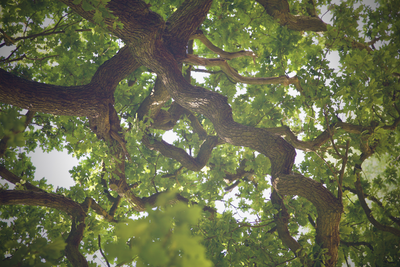
Contact
- PRIMARY STUDIOS, 33, SEELY ROAD, NOTTINGHAM
- NG7 1NU
Blog
- 08/05/2025 09:31 PM
The Forest Fork is tuned to an ancient Oak Tree near the old visitors centre in Sherwood Forest - 32HZ. Getting it ready for the Forest exhibition at Nottingham Castle.
Read More- 16/04/2025 08:58 PM
The Forest Bell canopy is currently being fabricated for Nottingham Castle. Here - welding the top from where the bell will hang.
Read More